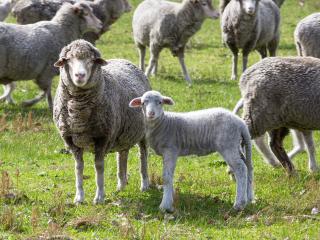Sheep producers are being supported to boost lamb survival and marking rates at the Department of Agriculture and Food’s Regional Sheep Updates this month.
The department’s Lamb Survival Initiative and 100%+ Club are key activities that aim to sustainably rebuild the State’s sheep flock as part of the $10 million Sheep Industry Business Innovation project made possible by Royalties for Regions.
Sheep industry development officer Katherine Davies said it was vital the sheep industry in Western Australia increased its flock to improve the profitability of individual producers and the industry.
“There is an opportunity for the sheep industry to capitalise on the growing demand for sheep meat in our export markets,” Ms Davies said. “But to do so, the State’s sheep flock must be increased to a maintainable level.
“Key ways to sustainably rebuild the flock are to improve average marking and lamb survival rates.
“Lamb survival is affected by ewe nutrition during pregnancy and lactation.
“Inadequate ewe nutrition can result in an increased likelihood of ewe mortality during lambing, inadequate milk production leading to malnourished lambs, and possible abandonment in search of feed.”
Ms Davies said each lamb that survived to turn off age was worth at least $55 after accounting for input costs.
“The Lamb Survival Initiative aims to provide producers with the skills and confidence to address the reproductive opportunities and limits within their ewe flocks,” she said.
“Coordinated by local grower groups, producers are provided access to workshops and an experienced Lifetime Ewe Management facilitator to help increase lamb turn-off, management tools, and a subsidy on pregnancy scanning of ewes for multiple births.
“Producers are encouraged to record and submit data on the reproductive, marking rate and weaning rates achieved in their scanned ewe flocks, so it can be benchmarked against other producers in the region.
“Through benchmarking and involvement in local grower groups, individual producers will be able to support each other, share their successes, and work together to determine the strategies to increase lamb survival that best suit their operations.”
Data collected through the Initiative will also assist industry to form a clearer picture of lamb survival rates on farms throughout Western Australia.
Other tactics producers can consider to increase lamb survival include feed budgeting for ewes calculated using condition scores and Feed on Offer in the paddock; lamb paddock preparation to ensure shelter is available to minimise the risk of exposure and predator control; and smaller flock sizes to reduce the risk of mismothering.
Ms Davies said her presentation on the Lamb Survival Initiative and 100%+ Club at the Update in Moora would be complemented bypresentations on lamb survival at all other Regional Sheep Updates by sheep consultant Joe Young, who is working with Lamb Survival Initiative producers.
Updates will be held at Moora on 27 July, Merredin on 28 July, Katanning on 29 July and Ravensthorpe on 30 July.

Media contacta: Jodie Thomson/Dionne Tindale, media liaison +61 (0)8 9368 3937
